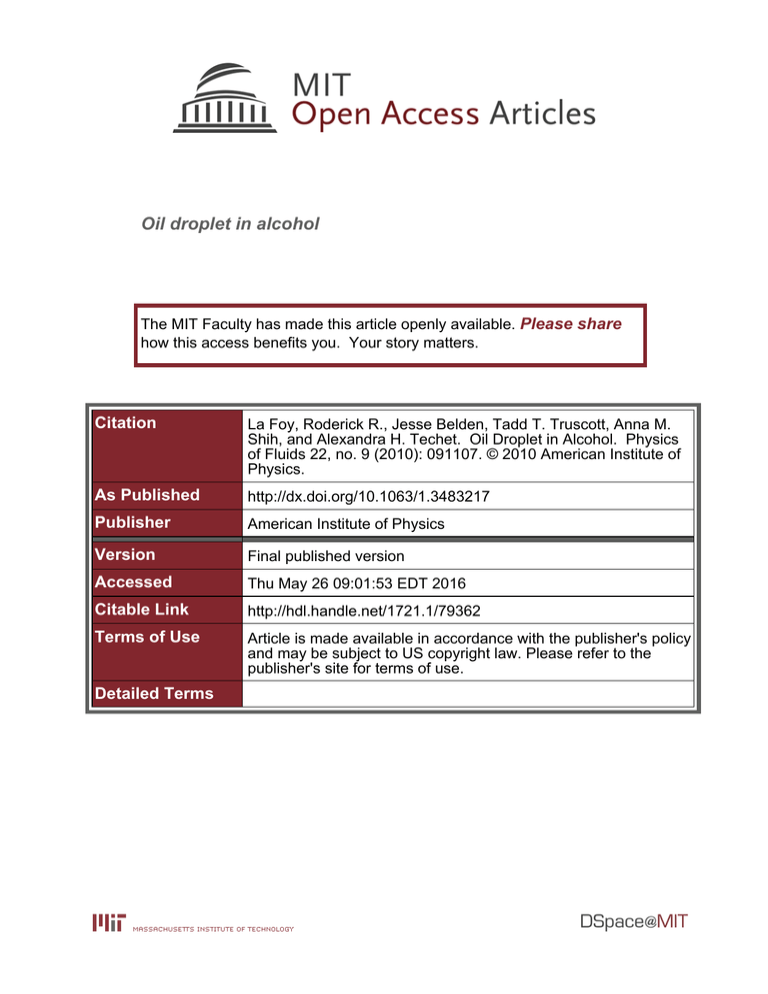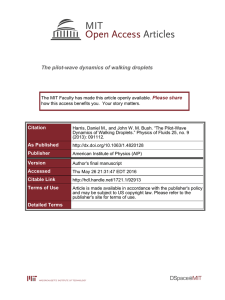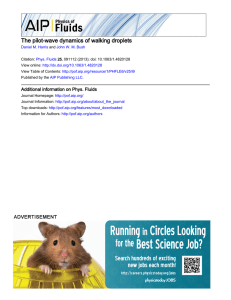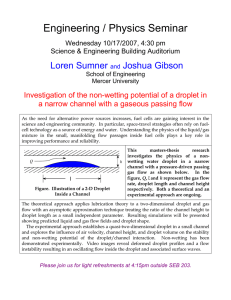Oil droplet in alcohol Please share
advertisement

Oil droplet in alcohol The MIT Faculty has made this article openly available. Please share how this access benefits you. Your story matters. Citation La Foy, Roderick R., Jesse Belden, Tadd T. Truscott, Anna M. Shih, and Alexandra H. Techet. Oil Droplet in Alcohol. Physics of Fluids 22, no. 9 (2010): 091107. © 2010 American Institute of Physics. As Published http://dx.doi.org/10.1063/1.3483217 Publisher American Institute of Physics Version Final published version Accessed Thu May 26 09:01:53 EDT 2016 Citable Link http://hdl.handle.net/1721.1/79362 Terms of Use Article is made available in accordance with the publisher's policy and may be subject to US copyright law. Please refer to the publisher's site for terms of use. Detailed Terms Oil droplet in alcohol Roderick R. La Foy, Jesse Belden, Tadd T. Truscott, Anna M. Shih, and Alexandra H. Techet Citation: Phys. Fluids 22, 091107 (2010); doi: 10.1063/1.3483217 View online: http://dx.doi.org/10.1063/1.3483217 View Table of Contents: http://pof.aip.org/resource/1/PHFLE6/v22/i9 Published by the American Institute of Physics. Additional information on Phys. Fluids Journal Homepage: http://pof.aip.org/ Journal Information: http://pof.aip.org/about/about_the_journal Top downloads: http://pof.aip.org/features/most_downloaded Information for Authors: http://pof.aip.org/authors Downloaded 10 Jun 2013 to 18.51.3.76. This article is copyrighted as indicated in the abstract. Reuse of AIP content is subject to the terms at: http://pof.aip.org/about/rights_and_permissions PHYSICS OF FLUIDS 22, 091107 共2010兲 FIG. 1. Formations made by an oil droplet falling through alcohol from drop heights of 25 mm 共top兲 and 50 mm 共bottom兲. Oil droplet in alcohol Roderick R. La Foy, Jesse Belden, Tadd T. Truscott, Anna M. Shih, and Alexandra H. Techet Department of Mechanical Engineering, Massachusetts Institute of Technology, Cambridge, Massachusetts 02139, USA 共Received 4 August 2010; published online 30 September 2010兲 关doi:10.1063/1.3483217兴 The elegant patterns formed by fluid droplets falling through a dissimilar liquid were first studied over a century ago.1 The emerging patterns are driven by hydrodynamic instabilities set up by velocity and density gradients between the liquids. We perform experiments using 3 mm droplets of naphthenic oil released from two heights 共25 mm, 50 mm兲 into isopropyl alcohol. The oil is denser than and miscible in the alcohol 共oil / al = 1.17兲, which results in the drop descending and eventually diffusing. Images are captured with a digital SLR camera looking at a black background through the tank of alcohol, which is lit from both sides. The difference in index of refraction between the oil and alcohol causes the edges of the oil droplet to appear brighter than the surrounding fluid. For lower drop heights 共top sequence of Fig. 1兲, the oil droplet behavior resembles that described for miscible drops placed on the surface of a lighter fluid.2 Initially, large velocity gradients between the droplet and the alcohol cause the 1070-6631/2010/22共9兲/091107/1/$30.00 droplet to roll up into a vortex ring, which grows into an oscillatory shape as a result of Rayleigh–Taylor instabilities. The unstable ring stretches and then fragments into smaller and smaller rings, which creates cascading tiers of vortex rings, until diffusion takes over. When released from 50 mm above the free surface 共bottom sequence of Fig. 1兲, the droplet does not immediately cascade into tiers of vortex rings. Initially viscous shear on the outside layer of the oil droplet causes it to form into an upside-down “wine glass” shape. The thin sheet of oil rolls up into the first vortex ring, which expands radially as the droplet continues to descend. The droplet shape elongates as its denser core descends faster than the vortex ring. A second central vortex ring forms at the lowest point of the droplet, and then another ring follows suit thereafter. Each ring remains attached to the others by a thin oil sheet. Rayleigh– Taylor instabilities begin to set up the vortex ring cascade as witnessed in the top image sequence, which ultimately occurs for all of the central rings. 1 J. J. Thomson and H. F. Newall, “On the formation of vortex rings by drops falling into liquids, and some allied phenomena,” Proc. R. Soc. London 39, 417 共1885兲. 2 S. Residori, P. K. Buah-Bassuah, and F. T. Arecchi, “Fragmentation instabilities of a drop as it falls in a miscible fluid,” Eur. Phys. J. Spec. Top. 146, 357 共2007兲. 22, 091107-1 © 2010 American Institute of Physics Downloaded 10 Jun 2013 to 18.51.3.76. This article is copyrighted as indicated in the abstract. Reuse of AIP content is subject to the terms at: http://pof.aip.org/about/rights_and_permissions





